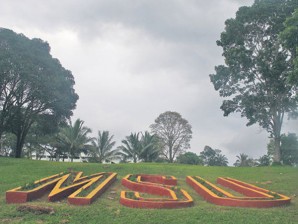
GOLDEN YEAR. Mindanao State University’s Marawi campus was carved out from a barren military reservation 50 years ago. RYAN D. ROSAURO/INQUIRER MINDANAO
Marawi City—Mindanao State University (MSU) celebrates its golden anniversary on Thursday true to its ideal as a beacon of hope in a rebellion-torn landscape.
Thousands of its alumni are to gather on this windswept campus 930 meters (2,800 feet) above sea level overlooking the placid Lake Lanao that is enveloped each day by a fog at dawn and at dusk.
A once barren military reservation of cogon grass, the university is now shaded with trees and adorned by a 24-hole golf course, a haven in a troubled and impoverished region.
The campus has provided a “stiff competition to the camps of rebels and militants in wooing the youth in conflict-affected areas,” said MSU president Macapado Muslim.
Socially, the university is hard-pressed to rethink its relevance in Mindanao’s evolving political and economic environment brought by changing winds of national and global affairs, including the increasing demand for shaping an effective multicultural society.
Life without MSU
The anniversary is an opportunity to celebrate “the transformative magic of MSU as an institution of learning,” Muslim said.
He cited the enormous impact of MSU in the development of Mindanao.
“I, myself, who is a son of unschooled parents, cannot imagine a life had there been no MSU,” said Muslim, a public administration alumnus.
“As a residential campus, MSU is a social laboratory where the best and brightest Muslims, Christians and Lumad from all over Mindanao converge to learn with and from each other,” said Alma Elape-Berowa, a social science professor.
National integration
MSU is a product of government efforts at national integration following the Kamlon rebellion in Jolo in early 1950s. It was created through Republic Act No. 1387, authored by Sen. Domocao Alonto.
Its mandate is to accelerate the integration of the Muslims and cultural minorities into the mainstream of national life, and provide the technical manpower needed for the socioeconomic development of Mindanao, Sulu and Palawan.
Although passed in 1956, the university was not able to operate until 1961. Classes first opened in June 1962 with 282 students and 12 faculty members.
From its original campus here, the university has now grown into 11 collegiate campuses spread across four of Mindanao’s six regions. Its autonomous unit, Iligan Institute of Technology, is “a jewel in science and technology,” Muslim said.
As of the first semester this year, the university’s 11 campuses cater to 54,649 students, making it among the largest higher education schools in the country. It has 3,295 faculty members. Since its first graduation in 1966, MSU has turned out 127,451 graduates.
Muslim said the university’s excellent training has been consistently shown in the topnotch performance of its graduates in licensure examinations.
For the books
Just like the Marawi fog, tuition in the university has remained the same the last 49 years, at P80 for a 15-unit load. That means P5.33 per unit.
Add the P50 library fee and other miscellaneous fees, a student spends a total of P1,000 a semester.
“This one’s really for the books,” Muslim said.
He blamed this fee structure for costing the university’s “academic decline.”
With reduced government subsidies amid a rising student population, Muslim stressed the importance of “adjusting the cost of MSU education to a realistic level” that reflects its actual financial needs.
Poor finances
Its share of the subsidy pie has shrunk following the mushrooming of state universities and colleges the past years. From only two in 1965, Mindanao now has about 30, many of which were created on political behest.
With poor finances, MSU has had a hard time meeting its basic academic needs like laboratory facilities and library resources.
Muslim particularly cited the main campus, which has a deficit of at least 52,000 book titles in its library, estimated to cost P156 million to acquire.
Per standard, there should be some 10,000 book titles as core references, and each student should be allocated at least five books. With at least 16,000 students the previous semester, this means of 90,000 book titles as against only 38,000 in the university’s hoard.
MSU’s board of regents approved in 2003 a calibrated tuition increase from P5.33 per unit to P100 per unit.
Accessibility
Muslim is confident that scholarship privileges for excellent academic performance and affirmative action grants for indigenous peoples would balance the impact of a tuition rise.
Another accessibility concern is bridging graduates from community schools whose instruction in basic education is hampered by intermittent conflicts.
Recently, MSU spruced up its college-bound program for high school graduates. There is also the one-semester college preparatory course for those who failed to get the cut-off score of 75 in the entrance exam.
The preparatory course trains only in Math, English and Values, called the tool subjects.
Remedial classes and “booster reviews” are also held for students in MSU feeder schools who are to take the university entrance exam. Many of these feeder schools are now under the wing of MSU.
Reforms
Through financial and administrative reforms, Muslim was able to raise the income of the main campus from around P1.5 million in 2007 to P62.5 million in 2010.
Muslim also dealt with wasted electricity by cutting off from its power distribution system connections outside of the university operations, saving it P1 million in monthly bills.
Because of these internally generated finances, the university was able to acquire new books and laboratory equipment. A dormitory project has been completed after 18 years.
By successfully achieving excellence and the comparatively low-cost of education, MSU has served as a primary option for acquiring a college degree for Mindanao’s poor. And the increasing throng of enrollees is posing a continuous challenge to the university.
“We have to reinvent our institutional capability from time to time. This is far better than letting go of these young people into wayward pursuits,” Muslim said.

